
WHOSE ADVANTAGE?
That sector of the security industry that resells, installs and at times monitors electronic systems for residential and commercial customers continued its healthy growth last year.This year, the sector plans continued strong purchasing of burglar and fire alarms, more sophisticated systems and especially CCTV surveillance as well as some growth in non-alarm home systems.
Busts Through $14 Billion
According to the annual SDM Industry Forecast, the sector busted through $14 billion in revenue in 1997, with 5.2% growth over 1996. In a first-time "same-question" survey of SDM 100 firms, the largest dealers that install, this group reported 1996-97 growth of 14.8%.
For 1998, the largest dealers see prolonged revenue growth of 15.4%, while the bulk of the sector -- mostly local dealers -- are extremely cautious, projecting a mere 1.1% in revenue growth.
Always a sector with many small, local dealer businesses and fewer, pace-setting regional and national firms, the group has grown more comfortable with its paradoxical evolution.
Inside of Growth
On the one hand, the local dealers see increased customer demand, better marketing and home growth in their specific coverage area as top reasons for increased 1997 revenue. On the other hand, the largest SDM 100 firms peg their success last year to "working the plan:" through internal growth and acquisitions more than increased customer demand.
Most respondents, no matter size or geographic coverage of their firms, do share the feeling that, this year, three factors -- the economy, crime and sales and marketing efforts -- primarily will push up or pull down the sales of security systems. And that the three drivers primarily play out locally: cities and regions have stronger or weaker economies and housing activity.
According to Daryl Delano, of Reed Elsevier Business Economics, the U.S. economy remains fundamentally sound. The current economic expansion -- which began in the spring of 1991 -- will continue through 1998. Federal Reserve Board and Clinton Administration economic policy makers have continued to do an outstanding job of guiding the economy between the twin risks of recession and accelerating inflation, says Delano.
In the U.S., overall growth in GDP should reach 2.3% during 1998, with business investment and exports again leading the way. Inflation will remain relatively benign, and long-term interest rates will stay low enough to keep housing investment, consumer durable goods purchases, and business capital spending at reasonably solid levels.
While economists generally see moderate though steady growth of the economy this year and next, some contend there's a growing chance of a recession, say a 25% chance, by 1999. And housing growth, tied inherently to the sale of residential security systems, will decrease slightly (2-3%) this year, according to builder groups.
Impact of Crime
Crime overall also is decreasing, but at a much faster rate and over nearly five years.
Yet, declining crime rates have yet to have a dampening affect on the sale of electronic security. Local crime concerns and the general citizen perception of crime and morality tend to -- so far -- outweigh the descend. Security dealers also have diversified into commercial and corporate businesses, where crime and security concerns continue to rise, and into home systems, unaffected by crime rates.
Among the sector's paradoxes, consolidation continued in 1997, with gas and electric utilities joining phone company Ameritech as "big buck" buyers, in addition to aggressive regional and national security firms. But the pressure of consolidation hasn't much changed the total number of businesses: a little more than 16,000, with the bulk still local, independent firms.
Consolidation Rates
Almost 11% of firms in the SDM Industry Forecast say they purchased another security-installing company during the period October 1996 to September 1997. But about 60% of those acquisitions were made by the largest firms, with revenue of $1,000,001 or more. According to survey respondents, 1998 should prove a "lull" year as growth through acquisitions slows. An analysis of a decade of SDM Industry Forecast reports shows a pattern of two or three years of double-digit acquisition activity, then a "lull" year or two.
This year, shifting attention from acquisitions, say survey respondents, are crucial issues closer to home: protecting profit margins; finding and retaining good employees; and selling more systems. Concern over profit margins is a recurring issue in the SDM Industry Forecast and may become an even sharper and potentially divisive issue this year.
At the November 1997 Security Industry Association Forum, the annual meeting of manufacturing and monitoring executives, some speakers suggested that the hardware price wars (free and $99 deals) may shift to monthly monitoring fee give-away deals as utilities view home security systems as more a strategy to bundle services and hold onto customers than as lucrative recurring cash flow.
Quality Employee Base
Beyond profit margins, concern over finding and retaining good employees makes its first appearance in the top worries of dealer, installer and monitoring firms.
With unemployment at its lowest in a number of years, and the shifting of attention inward, it's not surprising that firms of all sizes now are concerned about the quality and stability of their workforce.
Instead of paradoxical, some survey results are consistent. The resale of burglar alarms, for example, accounts for more than half of the sector's revenues, with fire alarms amounting to about 17% of total revenues. As a percent of total revenue, CCTV surveillance systems have climbed again last year; the sector rated CCTV as the fastest growing part of their business. There's also growth in access control systems and home systems.
Monitoring Income Paradox
Looking at revenue from a service perspective, residential sales and installation account for more than a third (35%) of revenue, while non-residential sales and installation, growing strongly, now account for a little more than one-quarter (26%) of revenue. For the entire sector, monitoring is 20% of total revenue, although it accounts for a little more than seventy percent (71%) of revenue of the SDM 100 firms.
More than half (54%) of the SDM Industry Forecast respondents continue to see residential, and especially high-end residential, as the source of most revenue growth. But small commercial continues to grow as an attractive target market.
When the survey shifted from revenue sources to the average price of hardware, installation and monitoring, things become a bit more complex.
Pricing Stable or Not?
In 1997, all respondents reported the average hardware and installation price of a residential system was $1,428. However, in an analysis of results of the SDM 100 survey and the weighting of systems by the largest, mass marketing firms, an average price of residential hardware and installation falls to $350 per system.
There's more consistency in monthly monitoring fee. The average: $24.40 per residential system.
Most SDM Industry Forecast respondents feel that sales and installation as well as monthly monitoring will remain about the same this year.
Not remaining the same but decreasing sharply has been crime, the growth and fear of which drives sale of security systems, say many dealers in the SDM Industry Forecast. In a way, the growth of electronic security in residential and non-residential facilities can take responsibility as one factor in improving the crime picture.
Serious Crime Continues Drop
Serious crime in the U.S. dropped significantly for the fifth year in a row, according to preliminary Uniform Crime Reporting (UCR) figures for the first half 1997.
Still, using the latest U.S. Department of Justice Victimization data which go beyond crimes reported, about five Americans out of 100 (5,079 per 100,000) were victimized by criminals in 1996.
The UCR report ticks off a crime every two seconds, and a violent crime every 19 seconds, a murder every 27 minutes, a forcible rape every six minutes, and a car stolen every 23 seconds.
The Perception of Crime
The enigma: crime continues a downward trend, yet it continues to touch many people, with more people sensitized to crime, even incidents far away, and demanding tougher prevention and punishment programs.
The greatest drop: in the most densely populated urban areas, where community policing, crime prevention programs and electronic security systems are most used.
The nation's law enforcement agencies reported a 4% decrease in serious crime during the first 6 months of 1997 when compared to figures reported during the same time period of the previous year, according to Uniform Crime Reporting Program figures released today by the Federal Bureau of Investigation. The FBI figures are a compilation of crime incident reports from local law enforcement agencies.
Violent crime decreased 5% and property crime fell 4%.
Among the property crimes, arson decreased 9%; motor vehicle theft and burglary both dropped 5%; and larceny-theft declined 4%. Serious crime decreased in all of the geographic regions. Declines recorded include 6% in the Northeast, 5% in both the Midwest and West, and 3% in the South.
All cities showed a decline in serious crime for the 6-month period, with the largest population groups, cities over 250,000, recording the largest decline, 6%. The decreases reported by suburban and rural county law enforcement agencies were 3% and 1%, respectively.
About the SDM Industry Forecast
The SDM Industry Forecast is based on random-sampling questionnaires of dealer, installer and monitoring firms and complementary personal interviews conducted in September, October and November. New this year: a survey of the SDM 100. The master survey also contains some answers from SDM 100 companies, but at a rate reflecting their number within the total number of firms overall.
Commercial, Corporate Security Has Bold Equipment, Install Plans
With new construction and major remodeling projects common across the commercial and government building sector, and with business buying more leading edge electronic security systems, the non-residential side of private sector has become even more attractive to dealer, installing and monitoring service firms.It's also the area, according to the SDM Industry Forecast, where dealers can more easily transform themselves into higher level systems integrators as well as hold appealing profit margins over the course of a longer and closer customer relationship.
The private security industry in the U.S. is about $80 billion, of which the $14.05 billion in the dealer sector is a subset, according to the SECURITY Magazine Industry Forecast, which tracks commercial, corporate, government and institutional security plans and spending. Add to that the $90 billion for law enforcement and $69 billion for corrections, jails and prisons.
In this arena, corporate security executives have both an overview and narrow view of the application of technology to solve problems.
According to the SECURITY study of 1998 concerns, employee theft, property crime and access controls are at the top with violence parking lot security and burglary among the top, too.
Matching results of the SDM study, the SECURITY research shows CCTV surveillance systems at the very top of the "plan to purchase" list of corporate security buyers. Also in the top ten: locking hardware including electromagnetic locks; electronic access control systems; security lighting; and burglary alarms.
EXECUTIVE SUMMARY
The SDM Industry Forecast, security's longest-running study of the electronic security dealer, installer and monitoring sector, reports many firms foresee a strong 1998.
But there are numerous challenges: pressure continues to build on their entire sector with mass marketing of alarms and monitoring by the largest firms as well as the threat of a monitoring price war by utilities that view security as much as the glue to help keep bundled services together as others view it as the cash-flow pillar of the security industry.
ELECTRONIC SYSTEMS SECTOR
- There are about 16,100 separate business units that deal, install, monitor or provide related services.
- These business units are rather uniformly distributed, when categorizing them by individual unit revenue. About 4,300 units have revenue of $100,000 or less; about 3,800 have revenue of $1,000,001 or more.
- When viewing units as part of a parent company or affiliate structure, the number of firms with revenue of $100,000 or less make up 33.8% of the total, while the number of firms with revenue of $1,000,001 or more make up 17.1%.
- Revenue for 1997 in the sector is $14.05 billion.
- The largest firms -- with revenue of $1,000,001 or more -- have about 74% of total sector revenues.
- Revenue growth from 1996 to 1997 was 5.2%.
- The largest firms -- as reflected through the SDM 100 security dealer companies that install -- report revenue growth of 14.8% 1996 to 1997 as compared to 5.2% for the entire sector.
- The total sector projects an extremely conservative growth rate of 1.1% for 1998 as compared to 1997.
- The largest firms -- as reflected through the SDM 100 -- project revenue growth of 15.4% for 1998 as compared to 1997.
- Mergers, acquisitions, partnerships and alliances continue to impact the sector. About 10% purchased another security-installing company during the period October 1996 to September 1997. More than one-third (35.2%) belong to an authorized dealer program.
- About 60% of acquisitions October 1996 to September 1997 were made by the largest firms, with revenue of $1,000,001 or more.
- Economic conditions and crime, especially within the geographic reach of the security business, are the two most important factors that will affect sales of security systems in 1998.
- Protecting profit margins; finding and retaining good employees; and selling more systems are top challenges in 1998.
- Burglar alarm, CCTV surveillance and fire protection systems were most often bought and resold by dealers in 1997.
- CCTV surveillance, burglar alarm and fire protection systems are the top planned purchases for resale in 1998.
- Home theater systems show very strong growth for 1998, although about 24% of this sector handles the technology.
- Most firms (61%) believe the current average price of a single-family residential security system will remain the same in 1998.
- And most firms (78%) believe the current average monthly monitoring price ($24.40) will stay about the same in 1998.
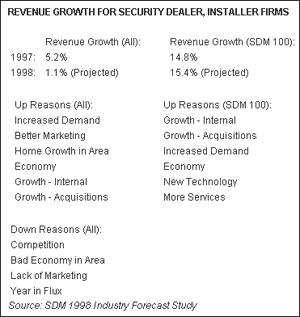
REVENUE GROWTH FOR SECURITY DEALER, INSTALLER FIRMS
The largest firms are the most encouraged about high growth this year, although all firms in the sector see strong residential, non-residential and diversified systems growth.
TOTAL REVENUE FOR SECURITY DEALER, INSTALLER FIRMS
Security dealer, installer and monitoring firms report that solid 1996 growth repeated in 1997. The largest firms were most bullish in 1997.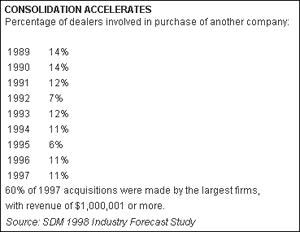
CONSOLIDATION ACCELERATES
Mergers, acquisitions and partnerships continue to change some of the make-up of the dealer sector. The vast majority of acquisitions (60%) are by the largest firms.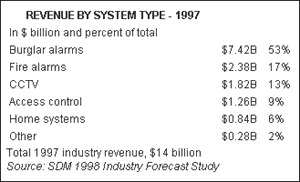
REVENUE BY SYSTEM TYPE - 1997
CCTV surveillance grabbed the greatest growth in 1997, while burglar and fire alarms continue to comprise most of the business last year.
REVENUE BY TYPE SERVICE - 1997
For most security dealer firms, significant revenue flows from residential and non-residential equipment and installation, while, for the larger firms, significantly more revenue flows from monitoring.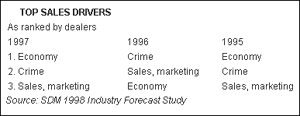
TOP SALES DRIVERS
While more dealers see potential in small commercial and large commercial business, fewer see non-residential building activity and capital spending by business as significant factors driving their revenue.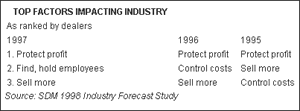
TOP FACTORS IMPACTING INDUSTRY
For the first time, dealer firms have ranked the ability to find and retain good employees as one of the top three factors that are major challenges for the businesses in 1998.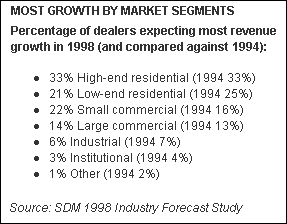
MOST GROWTH BY MARKET SEGMENTS
The movement: especially for smaller firms, it's to small commercial while larger firms are concentrating more on low-end residential and large commercial customers.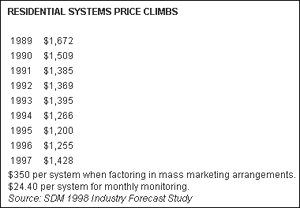
RESIDENTIAL SYSTEMS PRICE CLIMBS
Overall, the average price of a residential system has again increased. Mass marketing techniques and bundling bare-bones systems with two and three year monitoring contracts -- often through the largest firms -- brings down the average system price when these "deals" are factored in.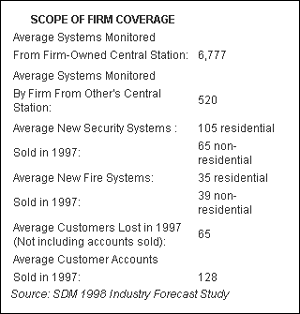
SCOPE OF FIRM COVERAGE
For the entire sector, about 60% of systems monitored are residential and 40% are non-residential. More than one-third (36%) say the number of accounts they will sell to others is increasing.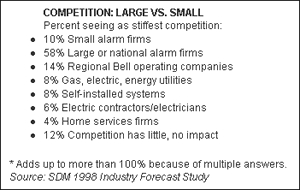
COMPETITION: LARGE VS. SMALL
While top industry leaders and Wall Street talk about utilities, the bulk of the dealer sector takes utilities less seriously than firms already well-established in the business.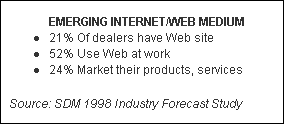
EMERGING INTERNET/WEB MEDIUM
The Internet - World Wide Web gets surprisingly strong attention from a minority of dealers. Most use the Web to gather technical and products information, but about one-quarter also use it to market their own firm to their residential and non-residential customers..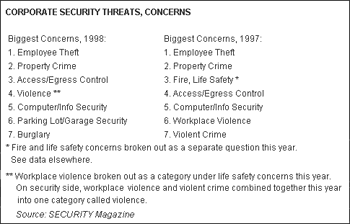
CORPORATE SECURITY THREATS, CONCERNS
Dealers can concentrate on CCTV surveillance, communications and access systems that target increased protection for personnel and assets, in lobbies, in parking lots and with computer gear.
TECHNOLOGY PURCHASED IN 1997, PLANNED FOR 1998
CCTV continues its reign as the "number one" category of technology purchased last year and planned to purchase by commercial and corporate security buyers.Marathon Economy Proves It Has Staying Power
By Daryl Delano, Reed Elsevier Business Economics
Executive Summary
The U.S. economy remains fundamentally sound. The current economic expansion-which began in the spring of 1991-will continue through 1998. Federal Reserve Board and Clinton Administration economic policy makers have continued to do an outstanding job of guiding the economy between the twin risks of recession and accelerating inflation.
Overall growth in GDP should reach 2.3% during 1998, with business investment and exports again leading the way. Inflation will remain relatively benign, and long-term interest rates will stay low enough to keep housing investment, consumer durable goods purchases, and business capital spending at reasonably solid levels. Government spending will again contribute little to the net gain in GDP during 1998, making this long, self-sustaining, private-sector-driven economic expansion all the more impressive.
The Marathon Continues
We see a continuation of generally favorable economic conditions in the United States during 1998. As 1997 comes to a close, we're enjoying the benefits of the third longest period of economic expansion in the past half-century. The last full-scale U.S. recession-and a relatively mild downturn, at that-ended in March 1991. There's nothing on the horizon to suggest that this expansion can't continue (at a moderate pace) through 1998. Recession concerns become more real as we enter the final year of this millennium, but we'd still place the odds of an absolute downturn in the economy-as contrasted with simply a slowdown in the rate of growth in real GDP-at less than 50%.
Following growth in Gross Domestic Product (GDP) during 1994 that reached 3.5%, real economic growth slowed to a 2.0% pace in 1995. Although it appeared to most forecasters that 1994 would ultimately be recorded as the best year of this economic expansion, preliminary indications are that GDP grew by an even stronger 3.7% during 1997. A pleasant surprise, to say the least, especially since it came with no appreciable run-up in either wage or price inflation.
We expect to see a pronounced slowdown in economic growth in 1998, however. GDP will rise by an inflation-adjusted 2.3% in 1998, down from the heady 1997 level (as measured on an annual average basis). Interest rates should average slightly higher in 1998 as the Federal Reserve Board pursues a marginally tighter monetary policy. The prime interest rate will rise to an average of 8.6% in 1998 from 8.4% in 1997.
Three major trends bear watching during 1998, and all will have some moderating influence on the U.S. economy's growth potential: 1.) A pronounced slowdown in the growth rate of business investment spending; 2.) High levels of consumer debt, particularly installment (credit card) debt; and 3.) An up-tick in inflation brought about by increased average wage demands resulting from historically low levels of unemployment.
None of these factors is significant enough by itself to cause the U.S. economy to stall out in 1998. The relatively stable nature of our exclusive indicator of business sentiment-the Reed Elsevier Business Confidence Index-suggests continued cautious optimism on the part of the business community. The momentum built up during the past five years, fueled in large part by productivity-improving business investments, will keep the economy rolling-albeit with a bit more friction during 1998.
Slow and Steady Will Win the Race
In fact, it can be argued that slower growth is just what the economy needs at this point in order to increase its chances of continuing to expand through the end of this millennium. You might say it's just what the doctor ordered (Dr. Greenspan, that is!). If we can make it through next year without a recession (something that we believe is much more likely than not), then this expansion will be as long as the 93-month-long boom period of the 1980s. If we can make it through to the end of this century (until December 1999, on the very cusp of the new millennium), then this expansion will exceed even the 1960s' Camelot period for duration. At that point it would represent the longest of the ten expansions that have materialized since the end of World War II.
The economic expansion that began in the spring of 1991 has taken on the characteristics of a tired, but well-conditioned, marathon runner. It seemed to get its "second wind" during 1997 with its 3.7% pace, well ahead of the plodding growth rates of the prior two years. It still shows no sign of exhaustion-fueled and replenished by the Gatorade tonic of business investment-although its pace is likely to slow in the months ahead.
The finish line at this point can be seen as the date when this expansion would set the record for the longest duration of the past half-century. In December 1999, the expansion would be 105 months old, besting the 104-month-long-expansion of the '60s. With that goal in sight, the current age of the expansion puts it just past the 20-mile mark-with "10K" to go!
If we make it to the new millennium, this expansion will have proved its remarkable stamina and endurance. And reaching the finish line doesn't mean that economic activity will collapse from exhaustion; it could-and should-still be standing. With the right monetary and fiscal policy moves (and a fair amount of luck) the economy could keep jogging, at least into the early months and years of the new millennium.
However, the party will eventually come to an end-maybe with a bang, more likely with a whimper. As Fed Chairman Greenspan has taken great pains to point out, the laws of supply and demand have not been repealed. There's plenty of merit in the talk about a "New Economy", "New Economic Era", and "New Economic Paradigm". In fact, there are plenty of things different about the U.S. and global economies today when compared to previous decades. Significant structural changes have at least bent the old rules and challenged many of the tenets of economic theory.
But some of the conclusions about what this "New Paradigm" might mean for economic cycles are grossly exaggerated and ill informed. Business cycles will continue to occur, maybe not as quickly as night follows day, but with some regularity. Well-grounded monetary and fiscal policies, combined with the business community's enlightened new emphasis on long-term investment, have allowed us to enjoy a long period of relative prosperity. It wasn't just "dumb luck", even though we've had our share of good luck in the availability and price of some important supply-side factors.
What will trigger the next recession? Business overconfidence (in the form of excessive inventory investment), bad Fed or Clinton Administration policy decisions, an outside shock (like war, pestilence, and higher oil prices)? It's anybody's guess, but it will likely be some combination of things that will bring this expansion to a halt. In the meantime, we should all cheer the U.S. economy to the finish line of December 1999-and the satisfaction of having set a modern-era record for economic good judgment and good fortune.
Housing Market: We're Somewhere Over the Rainbow
By Kim Kennedy, Cahners EconomicsLike Glinda's celluloid moon hovering over Munchkinland, we in the housing industry have had a good witch watching over us during the 1990s. If you have a long enough institutional memory, you may remember the doomsday forecasts for the 1990s that predicted housing starts would fall below a million units annually, home values would decline a critical 2-3% per year, and builders would file Chapter 11 bankruptcies by the thousands.
Something tells me we're not in Kansas anymore, Toto. Today's reality couldn't be farther from that prognostication. We've just seen the second consecutive year in which housing starts exceeded 1.4 million units (we're betting on 1.44 million units by year-end 1997). And home sales reached record levels this past year. The only real complaint that builders have today is a growing shortage of skilled labor-and perhaps the age-old lament that profit margins are a bit too thin. In 1998, starts and sales will slow, but will remain at historically strong levels. Starts will slow to 1.385 million units and total home sales will fall by 4.2% to 4.7 million.
Where did the forecasters go wrong? Why were they predicting a twister when what we really got was a rainbow? Not one, but several, explanations are behind the new and improved outlook for the housing industry. Here's a look at what didn't go wrong (or what went right) for us.
Demographics: Follow the Yellow Brick Road
The doomsday predictions for the 1990s got the basic demographics right, but took a wrong turn at a major crossroads. The forecasts were predicated on the belief that the baby boom was moving out of its prime home-buying years, and the much smaller baby bust generation (now called Generation X) was moving into theirs. The logic assumed that because far fewer households would be buying their first home, demand for new houses would fall precipitously. Moreover, because fewer people would be buying homes, supply would exceed demand, causing the price of homes to fall.
A couple of important developments were missed by this analysis, however. First is the impact that immigration has had on the housing market of the 1990s. Immigration levels came close to their historical peak in the 1980s, and have reached a new peak in the 1990s. According to Harvard's Joint Center for Housing Studies, immigration has accounted for one-third of overall population growth in the 1990s. Nearly 900,000 immigrants have arrived in the U.S. in each year of the 1990s.
Furthermore, recent legislative efforts suggest that the climate for at least some classes of immigrants will become more amenable over the next few years. After tightening immigration laws in 1996, Congress is now considering legislation to loosen restrictions on immigrants from Central American countries (such as Nicaragua, Guatemala, and El Salvador), and provide favorable entrance rules for immigrants from former communist countries in Eastern Europe.
Immigrants are an important influence on housing demand. Although few buy a home immediately upon entering the United States, 67% own homes by the time they become citizens (about the same as the domestic-born population). Fannie Mae has recently issued a report that found immigrants could account for 21% of household growth over the next 15 years. And increasingly, immigrants are likely to buy a home within five years of arriving in the U.S. As a result, the number of foreign-born residents who become new homeowners could be 50% higher from 1995-2010 than during the previous 15 years.
Another development missed by the doomsday forecasters is that domestic demand for housing has not fallen off as expected. The baby boom generation is still contributing to the demand for housing (both in the first-time buyer and move-up markets), and the minority population is buying homes in greater numbers than ever before.
Home ownership rates, which stagnated throughout the 1980s, climbed to a new historic high in 1997 (an estimated 66.7%). This trend is partly due to efforts by Fannie Mae and Freddie Mac (and, to some degree, the Clinton Administration) to encourage more minorities to enter the homeowners' market. In addition, the aging of the population is working in favor of home ownership since home ownership rates rise with age. While less than 20% of households headed by someone under the age of 25 own their home, nearly 80% of households aged 65 and older are homeowners. And Freddie Mac reports that nearly 90% of Americans will own a home at some point in their lives.
Mortgage Rates: Ding-Dong, the Witch is Dead!
Another factor that cannot be overlooked in accounting for the strength of the housing market in the 1990s is mortgage rates. In October 1981, mortgage rates peaked at a wicked 18.5%. By 1990, they had declined to 10.1%, but were still in the double-digits-posing a psychological barrier for many potential homebuyers. Rates fell into the single digits in 1991 and have been below 10% ever since. In 1997, we expect mortgage rates of 7.6%, followed by 7.5% in 1998. Rates are now at the lowest level since 1972-with the exception of 1993 when rates dipped to an average of 7.3%-and will continue to be a lift for the housing market over the coming year.
Adding to the benefit of lower fixed-rate mortgages is the existence of adjustable-rate mortgages. Adjustable mortgage rates are expected to average 5.6% in 1997 and 5.7% in 1998. Adjustable rates have been a major advantage for builders in this business cycle since buyers have comfortably switched over to adjustable rates when fixed mortgage rates have risen. As a result, rate increases have not had the typical dampening effect on starts or sales.
Single Family Housing: Ruby-Slipper Protection Keeps the Market Skipping. Although both single and multi-family housing starts are expected to fall in 1998, the declines will be modest, and will merely return starts to a more sustainable level for the long run.
Favorable demographics and low mortgage rates have been protective "ruby slippers" for single family housing during the 1990s. After the 1990-91 recession, single family housing starts reached 1.2 million units in 1994-the highest level since 1978. They dipped in 1995 in reaction to a rise in mortgage rates, but rose again to hit 1.16 million units in 1996. This past year, they fell an estimated 3.9% to 1.12 million units, and will continue to slide by a humble 2.8% to 1.08 million units in 1998. Nevertheless, housing analysts consider any year above a million units to be a good one for the single-family market, and that has been the case steadily for the six years since 1992.
Multi-Family Housing: No More Emerald City
In 1997, the multi-family market proved more resilient than expected. Multi-family starts actually grew by 1.9% this past year to an estimated 322,000 units. This coming year, we expected the housing slowdown to catch up with the multi-family market, bringing starts down 6.8% to 300,000 units. Even this level, however, will be a strong one relative to 1990s construction activity.
Viewed in a larger historical perspective, however, today's new multi-family construction activity is pitifully small. In the 1970s, baby boomer demographics spurred extraordinary levels of activity-in 1972 alone, nearly 1.05 million multi-family units were built. If the 1970s level of multi-family construction were the equivalent of Emerald City, today's level would barely make a home for the tiniest Munchkin.
In the early 1980s, the tax advantages of passive losses (which meant that investors could use losses in one investment to neutralize taxes owed from gains in another) encouraged excessive development of multi-family projects that didn't make economic sense. When the tax laws were changed, starts steadily declined from 1985-1993-and came to a virtual halt during the early 1990s. By the 1991-93 period, starts averaged just 168,000 units each year. Therefore, despite the fact that today's demographics aren't particularly favorable for the multi-family market, pent-up demand from the early 1990s will probably be enough to keep levels at or around 300,000 units through the remainder of the decade.
Regional Starts: The Wind Began to Switch, the House to Pitch
Regional housing construction in 1998 will run contrary to recent performance. The regions that have grown at above average rates thus far into the 1990s will slow during the year ahead (the South and Mountain states), while those that have lagged behind will finally improve (the Northeast and West-particularly California).
According to the number of permits let during the first nine months of 1997, the growth markets have been in New England (up 7.4% from a year earlier), the Pacific (up 6.9%), and the West South Central (up 4.5%). In each of these areas it was multi-family housing that provided the big boost to permits. California, which ranked third among the states in the total number of permits let, gained 15.1% above its level a year earlier (single family permits were up nearly 10% and multi-family permits gained 39%).
Permit declines came from the Midwest (-7.5%), the East South Central (-8.0%), and the Mountain states (-4.7%). In the Midwest, the losses were due to frailty in the single family market, while the weakness in the East South Central and Mountains came from both the single- and multi-family sides, but most notably the multi-family market.
This has us believe that 1998 starts will perform best in the West-where they will be unchanged from 1997 at 347,000 units. The Northeast will see starts decline a modest 0.5% to 136,000 units. But larger declines will occur in the Midwest (down 6.2% to 281,000 units) and in the South (down 5.0% to 621,000 units).
Home Sales and Prices: Off to See the Wizard
The tremendous performance in home sales over the past couple of years has been a major impetus to new construction. Existing home sales set record levels in 1996 (at 4.09 million units) and again in 1997 (at roughly 4.12 million units). New home sales reached their highest levels since the peak years of 1977 and 1978 (at 756,000 units in 1996 and an estimated 790,000 units in 1997).
Over the coming year, sales will dip from these heights, but remain at a level that will keep the market hopping. Expect existing home sales to fall 4.5% to 3.93 million units, and new home sales to dip 2.4% to 771,000 units. That will place total sales down 4.2% from their 1997 peak to 4.7 million homes.
The slowdown in market activity will dampen home price appreciation during 1998. The median price of existing homes is expected to rise 2.6% in 1998, following a 4.2% climb in 1997. Nationwide, median prices will reach $126,000 in 1998.
In this expansion, new homes have gotten bigger and better. The latest Commerce Department report on the characteristics of new housing shows that the median square footage of single family homes grew 1.6% from 1992-1996 to 1,950 square feet. Similarly, the share of four-bedroom homes rose from 29% to 31% of the total, the share with three or more baths rose from 14% to 16%, and the share with a three-car (or more) garage rose from 11% to 14%.
Another measure that reflects a change in the size and amenities of new homes is the median price. From 1992-1996, the median price of new homes rose 15.2% (or 3.6% annually). In 1998, the median price of new homes will gain a more subdued 2.1% after 1997's vigorous 4.2% increase. This suggests that the size of 1998's new homes won't increase to the extent it has during the earlier part of the decade.
This is not to say, however, that large, luxury homes won't be an important part of the 1998 market. The difference between the average and median price of new homes suggests that the market will continue to remain top heavy. In 1998, the average price of new homes is expected to reach $179,300 compared to a median of $148,600. The difference between the two prices is large and growing-meaning that the luxury segment is either an increasing share of the market, or prices within the segment are increasing faster than the remainder of the market (both are probably true).
The bottom line: the housing market may be weakening from its apex, but it will remain at a level that will keep most builders happy and bustling over the coming year. If you ever again hear doomsday predictions for the housing market, don't be fooled. Remember that home ownership remains one of our most cherished of American dreams. More of us than ever believe, like Dorothy, that, "There's no place like home."